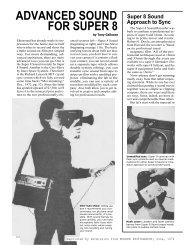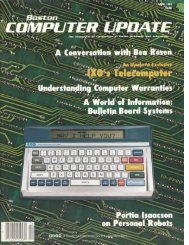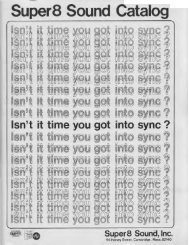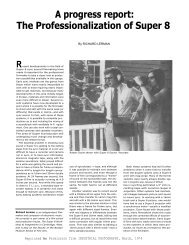established - Desktop Video Group
established - Desktop Video Group
established - Desktop Video Group
You also want an ePaper? Increase the reach of your titles
YUMPU automatically turns print PDFs into web optimized ePapers that Google loves.
By Tracy Robnett Licklider<br />
A RECOLLECTION:<br />
PERSONAL COMPUTERS IN THE<br />
BOSTON COMPUTER SOCIETY'S<br />
FIRST TEN YEARS<br />
We cruise down memory lane to check out what was hot<br />
and what was not during the past decade<br />
This is a look back at the revolution<br />
in personal computers as<br />
viewed, at least primarily,<br />
through The Boston Computer Society's<br />
general meetings, user groups,<br />
expositions, and publications: how a<br />
ten-year member of The Boston Computer<br />
Society might have seen it, read<br />
about it, and recollected the awesome<br />
experience.<br />
When The Boston Computer Society<br />
first formed in February 1977, personal<br />
computing was primarily the<br />
province of hardware hackers, hobbyists,<br />
and homebrew kit-builders. The<br />
personal computer industry had been<br />
born two years earlier, in January<br />
1975, when Popular Electronics<br />
magazine ran a cover story about the<br />
Altair 8800 personal computer kit by<br />
Micro Instrumentation and Telemetry<br />
Systems—or MITS, as it came to be<br />
known. That early ancestor of today's<br />
personal computer came with two<br />
boards and slots for 16 more in an<br />
open chassis. One board held the Intel<br />
8080 processor chip and the other<br />
held the 256 bytes—a mere one-fourth<br />
Apple's first ad was as rudimentary as its<br />
first office space.<br />
of 1K (a "K" equaling 1,024 bytes)—<br />
of memory. The unit's front panel had<br />
toggle switches for input and lights<br />
for output. The Altair sold for about<br />
$300 without a case, and for about<br />
$400 with one. This was the machine<br />
that Bill Gates and Paul Allen wrote<br />
the first Microsoft BASIC for—that<br />
first BASIC occupied a whopping 4K<br />
and required an add-on memory<br />
board.<br />
Southwest Technical Products<br />
Corp. was another early leader. In<br />
1975, its first kit cost $395 and<br />
provided a Motorola 6800-based system<br />
with a huge 2K of RAM. In addition,<br />
the SWTPC system could be<br />
connected to a teletype machine for<br />
input and output. Indeed, in the early<br />
days, owning a used teletype machine<br />
as an input/output device was the<br />
sign true of a pioneer power user. The<br />
earliest BCS meeting notices mentioned<br />
that a "TTY" (that is, a teletype)<br />
would be available at the<br />
meetings. By late 1977, Southwest<br />
had boosted its system up to 4K, still<br />
at the $395 kit price, and it offered a<br />
$500 kit for a simple video terminal<br />
that displayed 64 characters per<br />
screen line.<br />
Tracy Robnett Licklider is a contributing editor to Computer Update and a vice president of The Boston Computer<br />
Society.<br />
46 COMPUTER UPDATE








